Related Research Articles

Frederick George Peter Ingle Finch was an English-Australian actor of theatre, film and radio.

James Henry Leigh Hunt, best known as Leigh Hunt, was an English critic, essayist and poet.
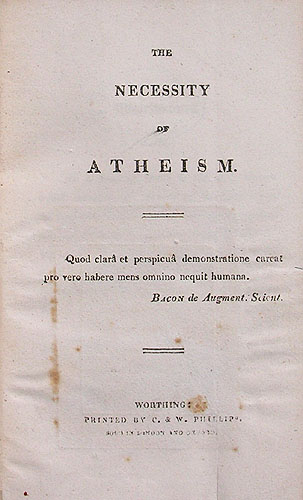
"The Necessity of Atheism" is an essay on atheism by the English poet Percy Bysshe Shelley, printed in 1811 by Charles and William Phillips in Worthing while Shelley was a student at University College, Oxford.

Sir George Cornewall Lewis, 2nd Baronet, was a British statesman and man of letters. He is best known for preserving neutrality in 1862 when the British cabinet debated intervention in the American Civil War.

Michael Charles Gauntlet Wilding was an English stage, television, and film actor. He is best known for a series of films he made with Anna Neagle; he also made two films with Alfred Hitchcock, Under Capricorn (1949) and Stage Fright (1950); and he guest starred on Hitchcock's TV show in 1963. He was married four times, including to Elizabeth Taylor, with whom he had two sons.

Henry Hetherington was an English printer, bookseller, publisher and newspaper proprietor who campaigned for social justice, a free press, universal suffrage and religious freethought. Together with his close associates, William Lovett, John Cleave and James Watson, he was a leading member of numerous co-operative and radical groups, including the Owenite British Association for the Promotion of Co-operative Knowledge, the National Union of the Working Classes and the London Working Men's Association. As proprietor of The Poor Man's Guardian he played a major role in the "War of the Unstamped" and was imprisoned three times for refusing to pay newspaper stamp duty. He was a leader of the "moral force" wing of the Chartist movement and a supporter of pro-democracy movements in other countries. His name is included on the Reformers' Memorial in Kensal Green Cemetery.
John Scott was a Scottish journalist, editor and publisher.

Robert Torrens was a Royal Marines officer, political economist, part-owner of the influential Globe newspaper, and a prolific writer. He also chaired the board of the London-based South Australian Colonisation Commission created by the South Australia Act 1834 to oversee the new colony of South Australia, before the colony went bankrupt and he was sacked in 1841. He was chiefly known for championing the cause for emigration to the new colony, and his name lives on in Adelaide's main river, the Torrens, the suburb of Torrensville and a few other places.
Samuel Ralph Townshend Mayer (1841–1880) was a British journalist and writer, the founder of the Free and Open Church Association.
The New Monthly Magazine was a British monthly magazine published from 1814 to 1884. It was founded by Henry Colburn and published by him through to 1845.
Edward Davis (1816–1841) was an Australia convict turned bushranger. His real name is not certain, but in April 1832 he was convicted under the name George Wilkinson for attempting to steal a wooden till and copper coins to the total value of 7 shillings. Sentenced to seven years transportation, he arrived in Sydney on the Camden in 1833 and was placed in the Hyde Park Barracks. Over the next few years he escaped four times: on 23 December 1833 from the Barracks, on 1 December 1835 from Penrith, on 10 January 1837 from the farmer he had been assigned to, and for a final time on 21 July 1838.
The Prince Rupert Daily News was a daily newspaper in Prince Rupert, British Columbia, closed in 2010. Its last owner was Black Press, the largest publisher of weekly newspapers in British Columbia, which owns the competing weekly Northern View.
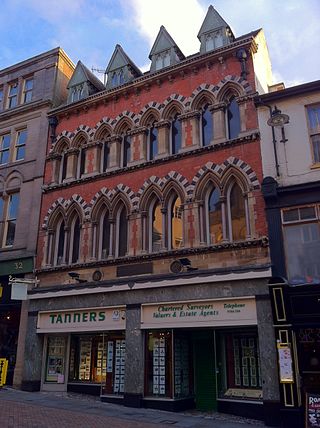
The Nottingham Journal was a newspaper published in Nottingham, Nottinghamshire, in the East Midlands in England. During that time, the paper went through several title changes through mergers, take-overs, acquisitions and ownership changes.
A statesman or stateswoman is a politician or a leader in an organization who has had a long and respected career at the national or international level.
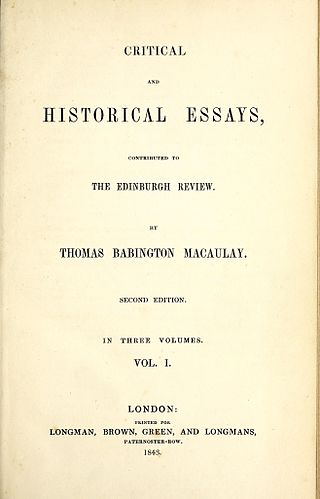
Critical and Historical Essays: Contributed to the Edinburgh Review (1843) is a collection of articles by Thomas Babington Macaulay, later Lord Macaulay. They have been acclaimed for their readability, but criticized for their inflexible attachment to the attitudes of the Whig school of history.
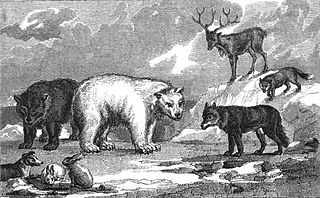
The Edinburgh Cabinet Library was a series of 38 books, mostly geographical, published from 1830 to 1844, and edited by Dionysius Lardner. The original price was 5 shillings for a volume; a later reissue of 30 of the volumes was at half that price. The publishers were Oliver and Boyd in Edinburgh, and Simpkin & Marshall in London.
The True Sun was a London, pro-Whig, evening newspaper that was first published on 5 March 1832 and ceased publication in December 1837. It was published daily except Sundays.
The Times is a newspaper published weekly in Victor Harbor, South Australia since August 1912. Its title has, as with most regional newspapers, undergone a series of name changes and simplifications over its history. It was later sold to Rural Press, previously owned by Fairfax Media, but now an Australian media company trading as Australian Community Media.
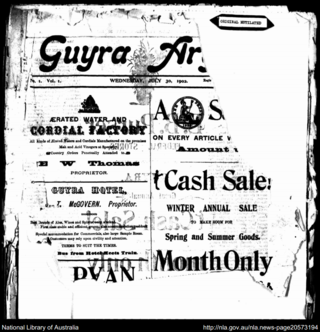
The Guyra Argus is an English-language newspaper published weekly in Guyra, New South Wales.

The Cambrian Quarterly Magazine and Celtic Repertory was an English-language quarterly magazine that published articles on Welsh and Celtic history and literature. Its aims were "to preserve 'native lore' for posterity and to win 'the incurious and indifferent into an interest for Wales'." It ran from 1829 to 1833.
References
- ↑ Weekly True Son (microform), Australian National Library
- ↑ Nord, Deborah Epstein (1995). "Leigh Hunt's Townsman essays". Walking the Victorian Streets . Cornell University Press. pp. 56–57.
- ↑ Hunt, Leigh - Regent's Park and Primrose Hill in Literature and Music
- ↑ The Statesman, or, The Weekly True Sun (microform), Australian National Library
- ↑ The British Queen and Statesman (microform), Australian National Library